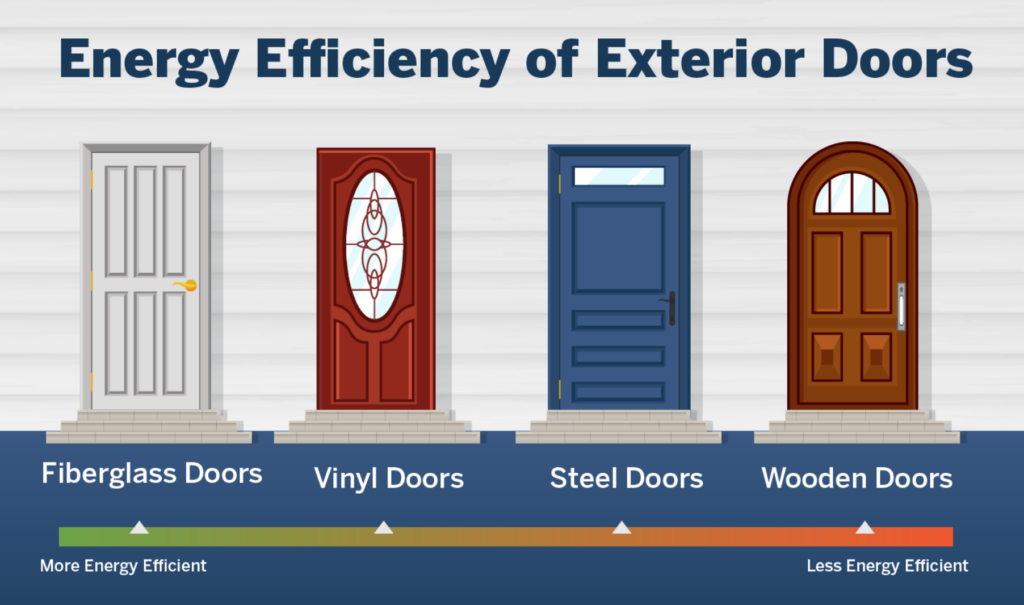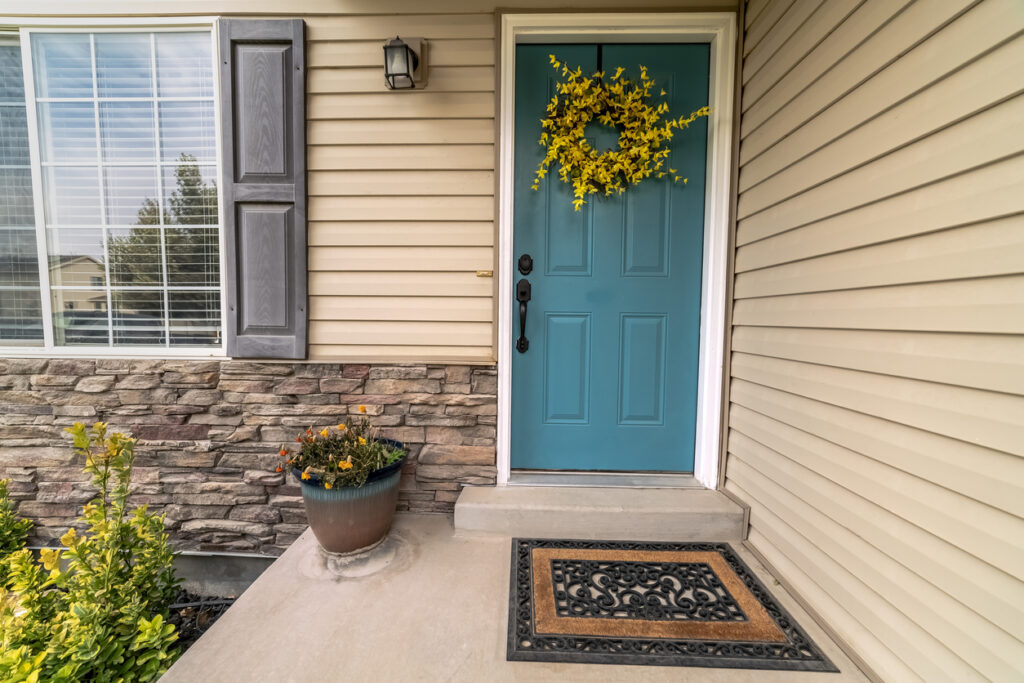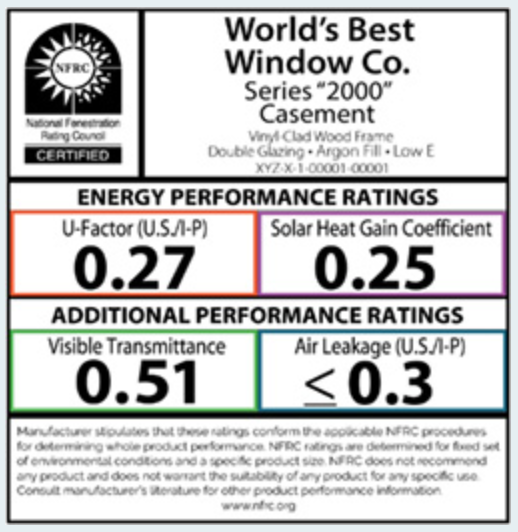A source of heating and cooling energy loss many homeowners may not be aware of is the energy lost through aging or improperly insulated doors. In this article we’ll help to clarify the hidden costs of inefficient doors and the variety of choices available for replacing older doors with energy-efficient styles or insulating your current doors to prevent heat and air loss.
The Hidden Costs of Inadequately Insulated Doors
According to Energy.gov, exterior doors can contribute to a significant amount of home air leakage if poorly sealed, and can also waste energy through conduction in the case of old, uninsulated, or improperly installed doors. Older doors may have gaps, cracks, or worn-out weatherstripping that allow air to leak in and out of the home, letting cold air creep inside in the winter and conversely, allowing heat to seep indoors in the summer. They can also allow heat to transfer easily both from within and from outside the home, especially when it comes to uninsulated doors or those having single-plane glass. The dual concerns of air leakage and heat transfer can result in drafts, uneven temperatures, and increased energy consumption as heating and cooling systems work to compensate for fluctuating temperatures. The wasted energy due to inefficient heating and cooling systems then translates to an increase in your utility bill along with the negative environmental impact caused by increased energy usage. Upgrading to energy-efficient doors or properly insulating your current doors can address these issues by improving insulation and reducing air leakage, helping you to conserve energy and save money.
The Benefits and Features of Energy-Efficient Doors
Energy-efficient door models with the Energy Star® label are manufactured to meet stricter EPA energy guidelines than their traditional counterparts, so you can be assured of their performance in lowering your home’s overall energy use. Their superior insulation abilities allow them to regulate indoor temperatures more effectively, putting less strain on heating and cooling systems and creating a more comfortable indoor environment. The energy savings from efficient doors also translates to savings on heating and cooling costs and a reduced carbon footprint. Some additional benefits are noise insulation, condensation prevention, and for doors with glass panes, blocking the sun’s UV rays.
In addition to the Energy Star® label, you will want to look for the National Fenestration Rating Council (NFRC) label to compare the energy performance ratings of specific doors. One important criteria to check for is the U-factor, which measures insulation efficiency. Doors with the Energy Star® label will have a U-factor of .30 or less, with lower numbers corresponding to increasing effectiveness in keeping your home cool in the summer and warm in the winter. The solar heat gain coefficient (SHGC), or the measurement of how well a door keeps out solar heat, can also be found on the label. A low SHGC number will keep your home cool in the summer, while higher numbers mean increased amounts of solar heat will be absorbed into the home. This number is important to consider for east- or west facing homes with front doors that receive several hours of direct sunlight per day. The R-factor is the final measurement of energy performance, and it is used to describe a door’s ability to resist heat flow. The ideal R-factor range is R5 to R6.
Types of Energy-Efficient Exterior Doors
The biggest factor determining a door’s insulating ability is the type of material it is made from. Older wood and glass doors are poor insulators, but newer doors made from fiberglass or steel possess excellent insulating ability, especially when combined with a polyurethane foam core. The image below illustrates the efficiency of exterior doors ordered by material type.

- Doors made from fiberglass are impervious to warping or expanding, making them one of the most durable and low-maintenance exterior door options. Their foam core gives these doors excellent insulating ability, and they can be found in a variety of styles and finishes.
- Vinyl is an affordable door alternative that is lightweight, yet still provides good insulation. However, it is good to be aware of placement, as lengthy exposure to sunlight can break down the plasticizers over time.
- With a layer of foam insulation incorporated within their outer metal frame, steel doors offer security and effective insulation and soundproofing ability. Due to their strength, steel doors will keep their shape and prevent gaps that lead air leakage.
- Many people love wooden doors for their natural beauty, but they lack the ability to insulate and are the least energy efficient door type. Their vulnerability to moisture also means that they require more maintenance. However, good weatherstripping and the addition of a storm door can go a long way toward improving the efficiency of a wooden door.
In addition to the energy savings generated by efficient doors, installing new qualified Energy Star® doors can qualify you for the energy efficient home improvement tax credit on your next tax return.
Test and Improve the Insulation of Your Exterior Doors
If you’re not ready to invest in new exterior doors or would like to improve the insulation ability of your current doors, there are a few simple tests that will reveal weaknesses in a door’s ability to retain heat or prevent drafts.
First, visually inspect the seal around your door. If any sections are missing or have eroded, it’s time to replace it. Next with the door closed, look for light shining through cracks around the door. Any light filtering through the door frame reveals that the door is not sealed correctly and heat is able to escape. You could also try to slide a dollar bill under and around the door to see whether it will pass through, in which case the door is improperly sealed. Finally, there are two tests you can perform to gauge your door’s insulation when the weather is cold outside. The first is to simply place your hand on the door – if it is cold to the touch, the door allowing heat to escape. The second is to light a candle near the door on a windy day. A flickering candle reveals areas of air loss where weatherstripping may be underperforming.
If you find that your door lacks an effective seal, installing new weatherstripping on its perimeter can go a long way toward reducing energy losses. There are many types of weatherstripping available for a variety of applications, so it is best to find the type of material best suited to your specific needs. Here is a helpful guide to help you choose the right material for your door.
Want to Learn More Ways to Improve Your Home’s Efficiency?
Doors that are energy-efficient help to keep out the elements and make your home more comfortable while saving money on energy costs. If you are unsure whether you need to upgrade your doors, hiring a professional to audit your home’s energy use can provide you with a wealth of information. Beyond learning specifically where to install new energy-saving doors or improve your current doors for the most value, a home energy score report details the most effective improvements you can make to improve energy efficiency for your entire home. Schedule your home energy score today!


